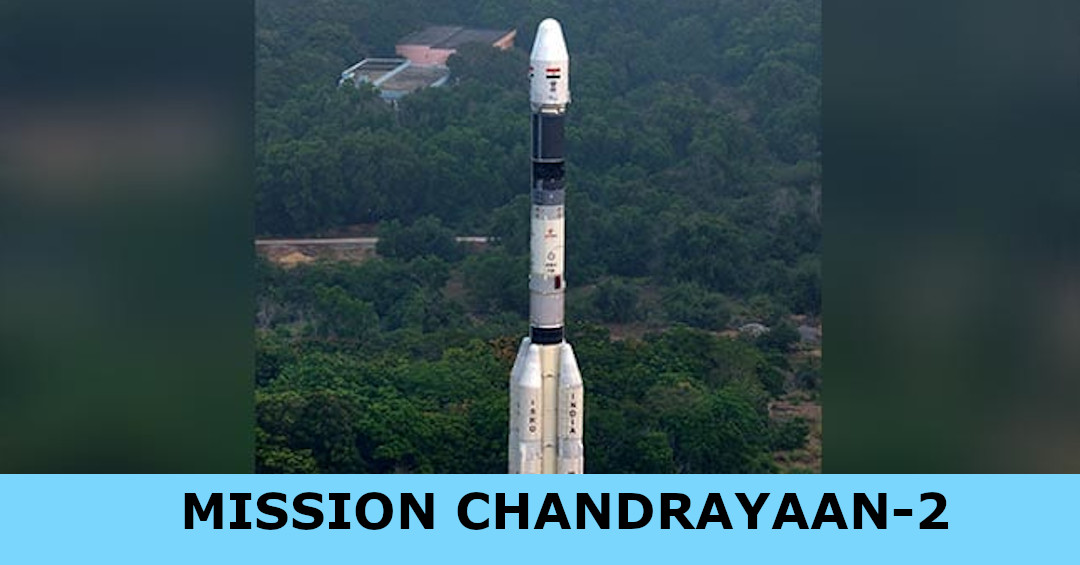Chandrayaan-2 is India's second lunar exploration mission after Chandrayaan-1. This is developed by the Indian Space Research Organization (ISRO). The mission is planned to be launched to the Moon by a Geosynchronous Satellite Launched Vehicle Mark III (GSLV Mk III). It includes a Lunar Orbiter, Lander and Rover, all developed indigenously. The main scientific objective is to map the location and abundance of lunar water.
This mission will attempt a soft landing of a Lander and rover a high plain between two craters. Manzius C and Simpleius N at a latitude of about 70 degrees south. The wheeled rover will move on the lunar surface and will perform on-site chemical analysis. It can relay data to Earth through Chandrayaan-2 orbiter and Chandrayaan-2 Lander, which will fly on the same launch.
This mission will help India and the world broaden the horizon of human knowledge. Mission Chandrayaan-2 will help India to explore the dark side of the moon after it lands on the cosmic body's south polar region. It will be launched onboard the Geosynchronous Satellite Launch Vehicle Mk-III, or GSLV Mk-III, rocket.
Chandrayaan-2 mission will help India's footprint in space, inspire a future generation of scientists, engineers, and Explorers and surpass international aspirations. Chandrayaan-2 is an advanced version of the previous Chandrayaan-1 mission, which was launched about 10 years ago.
It will be aided in achieving its mission by some of India's most advanced engineering marvels. Its integrated module, which comprises technology and software developed across the country, includes ISRO's most powerful launch vehicle to date and a wholly indigenous rover.
THE SCIENTIFIC OBJECTIVE OF CHANDRAYAAN-2
The Scientific objective of Chandrayaan-2 is to demonstrate the ability to soft-land on the lunar surface and operate a robotic rover on the surface of the moon. Scientists goals include studies of Lunar Topography, Mineralogy, Elemental abundance, the lunar exosphere, and signatures of hydroxyl and water ice. The orbiter will map the lunar surface and help to prepare the 3rd dimension (3D) maps of it.
The onboard radar will also map the surface while studying the water ice in the south polar region and thickness of the lunar regolithon the surface. The Chandrayaan-2 mission will inform the location and abundance of lunar water for exploitation by the future lunar base proposed by the Artemis program. It will go to the Moon's south polar region or we can say the dark side of the Moon.
Chandrayaan-2 mission is the first space mission to conduct a soft landing on the Moon's south polar region. This mission is the first Indian expedition to attempt a soft landing on the lunar surface with home-grown technology. After the Chandrayaan-2 lands successfully, India will be forth country ever to soft-land on the lunar surface. It's not a day trip and it takes days to reach there. The average distance between the Earth and Moon is 3,84,000 km. The Apollo astronauts of the 1960s and 1970s took three days to reach the Moon.
WHY IS INDIA LAUNCHING CHANDRAYAAN-2 MISSION?
This is because India wants to expand the nation's footprint in space, inspire a future generation of scientists, engineers and explorers and surpass international aspirations apart from broadening the horizon of knowledge of humans.
HOW WILL CHANDRAYAAN-2 MISSION BENEFIT INDIA AND THE WORLD?
The mission Chandrayaan-2 is a lunar mission that will go to the Moon's south polar region. This mission aims to improve the understanding of the moon. The discoveries will benefit India and the whole of humanity. These insights and experiences aimed at a paradigm shift in how lunar expeditions are approached for years to come.
WHAT MAKES CHANDRAYAAN-2 DIFFERENT FROM CHANDRAYAAN-1?
Unlike Chandrayaan-1, the Chandrayaan-2 will attempt to soft-land its Vikram module on the lunar surface and deploy a six-wheeled Rover, Pragyaan on the Moon to carry out several scientific experiments. The lift-off mass of Chandrayaan-1 was 1,380 kg while Chandrayaan-2 weights 3,850 kg.
WHERE WILL CHANDRAYAAAN-2 LAND?
Chandrayaan-2 will go to the Moon's south polar region- The dark side of the Moon. It is India's planned second mission to the moon, this mission consists of an Orbiter, a Lander and a Rover. The orbiter will perform a mapping from an altitude of 100 kilometers (62miles), while the lander will make a soft landing on the surface and send out the rover.
This mission will also send a small, 20-kilogram (44lbs), six-wheeled rover to the surface. The rover will move semi-autonomously, examining the lunar regolith's composition.
WHEN MISSION CHANDRAYAAN-2 WILL LAUNCH?
Mission Chandrayaan-2 was scheduled to be launched on 15 July 2019. But due to some technical Error on the launcher, it was canceled 56 minutes before launch and a revised date will be announced soon by Indian Space Research Organization (ISRO).
FOR MORE UPDATES STAY CONNECTED...
